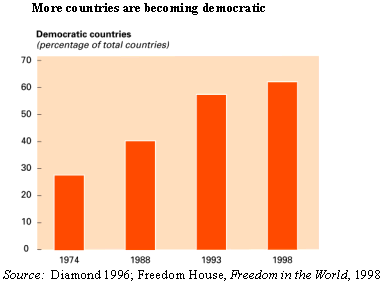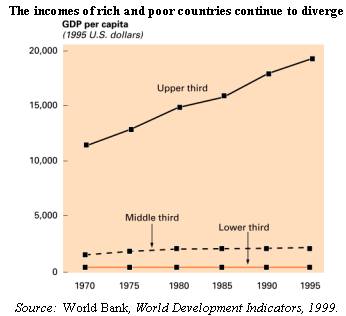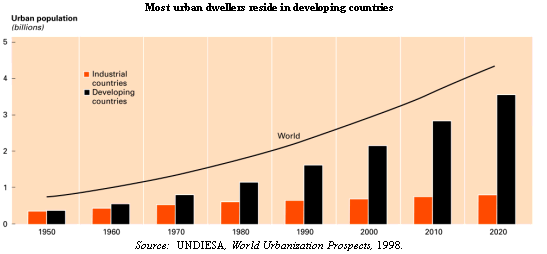Contacts:
Phillip Hay (202) 473-1796
Christopher Walsh (202) 458-2710
TV/Radio Cynthia Case McMahon (202) 473-2243
New report says twin forces of localization and globalization will shape future of the world economy
WASHINGTON, September 15, 1999 — Localization—the growing economic and political power of cities, provinces, and other sub-national entities—will be one of the most important new trends in the 21st century, according to a new World Bank report released today. Together with accelerating globalization of the world economy, localization could revolutionize prospects for human development or it could lead to chaos and increased human suffering, the report says.
According to the World Development Report 1999/2000: Entering the 21st Century, improved communications, transportation and falling trade barriers are not only making the world smaller they are also fueling the desire and providing the means for local communities to shape their own future. Faced with popular demands for greater self-determination, national governments from Africa to Latin America, and from Europe to South East Asia are devolving power to the local level—with mixed results.
"Globalization is like a giant wave, that can either capsize nations or carry them forward," says World Bank Chief Economist and Senior Vice President, Joseph Stiglitz, who oversaw the team that prepared the report. "Successful localization creates a situation where local entities and other groups in society—the crew of the boat if you will—are free to exercise individual autonomy but also have incentives to work together."
Localization is a mixed blessing
Localization can take the form of a general demand for broader popular participation in politics—such as the democracy movements in Poland and Brazil in the 1980’s, the Republic of Korea in the 1990s, and Indonesia today. Or it can take the form of demands for greater local autonomy, which may lead to decentralization or official recognition of a local cultural identity, as in Canada, Spain, and Uganda. Either way, localization can be a mixed blessing.
When it works, decentralizing power to the provincial and local level can result in more responsive and efficient local government. "There will be less room for close business dealings, more calls for accountability, and a continuing move away from the authoritarianism practiced in various parts of the world between the 1960s and the 1980s," the report predicts.
For example, in parts of Latin America, responsibility for public services such as education, health, local roads, and water supply and sanitation have been placed in the hands of semi-autonomous sub-national governments. In Colombia and Argentina, primary education has been decentralized to the intermediate levels of government, while in Chile it has been transferred to municipalities. Major increases in fiscal transfers to sub-national governments have also occurred, particularly in Brazil, Mexico, and Colombia.
But localization can also result in over-burdened local governments being unable to provide local infrastructure and services. Localization can threaten macroeconomic stability, and hence economic growth, if local governments borrow and spend heavily and need to be bailed out by national governments. And at the extreme, demands for local autonomy can lead to ethnic strife and civil war.

Globalization offers both opportunities and risks
Globalization also offers a mix of opportunities and risks. Expanded markets and the spread of technology can lead to higher productivity and improved living standards. But they can also lead to instability and undesired changes: fear of job losses due to the influx of foreign imports, financial instability due to volatile foreign capital flows, and threats to the global environment.
Globalization and localization are both inevitable, the report says. Whether a country succeeds in the 21st Century will depend on how well it manages these twin forces.
"Globalization and localization are transforming many aspects of our human experience today, and countries will either prosper or falter on how effectively they can grab on to these two forces and harness their energy," says Shahid Yusuf, the team leader of the 1999/2000 World Development Report team. "The world is becoming smaller, but in the process, it is also becoming more complicated. This makes a comprehensive and pragmatic approach to development more important than ever before."
The first half of the report focuses on three areas in which global cooperation is becoming ever more crucial: trade, financial flows, and environmental issues, such as bio-diversity and climate change. The second half considers three key aspects of localization: decentralization, cities as the engine of economic growth, and making cities livable.
Yusuf says that as globalization shrinks the world, and localization multiplies the range of policy environments, successful development strategies will pay off more quickly in the new century than in the past. By the same token, the consequences of flawed strategies will be revealed sooner and more painfully. "The purpose of the report is to identify approaches that have worked, to help countries and local communities develop and use successful development strategies," he said.
Lessons for development
To this end, the report identifies what it calls "four critical lessons" of development experience in the past half-century:
- Macroeconomic stability is essential for achieving the growth needed for development
- Growth does not trickle down, so therefore, development efforts must address human needs directly
- No one policy will spur development; a comprehensive approach is needed.
- Sustained development must be socially inclusive and flexible enough to adapt to changing circumstances.
These lessons, the report says, are "central to how the World Bank envisions its work in the 21st century and to the way in which it proposes to tackle the principal development challenges ahead." The report suggests that these findings will also be important for the Bank’s client countries, which are home to the world’s poorest people, and are likely to have the most difficulty in managing the twin forces of localization and globalization.
World Bank Group President James D. Wolfensohn says the report’s focus on the impact of localization and globalization on the poor highlights the need for development thinking to move beyond simplistic notions of economic growth to embrace a more comprehensive view of peoples’ lives:
"So far, economic commentary has focused on the onset of globalization with much less attention paid to the forces of localization. In both cases, however, what matters most is moving beyond traditional concepts of economic growth, to putting people - their health, welfare, education, opportunity, and inclusion - at the heart of the development agenda for the 21st century."
The report says that given current projections, the number of people living in absolute poverty will continue to increase. At the start of the new Millennium, an estimated 1.5 billion people will subsist on the equivalent of a dollar a day, up from 1.2 billion people in 1987. By 2015 the number of people subsisting below this international poverty line could reach 1.9 billion.
Moreover, based on recent trends, income disparities between industrial and developing countries will continue to grow.

Cities and human welfare
According to the report, a growing number of the world’s poorest people will live in cities. In 1950, the number of people living in cities was about the same in industrialized and in developing countries—about 300 million. By 2000, some 2 billion people will live in cities in developing countries, more than twice the number of urban dwellers in industrialized countries.
Many cities in developing countries are already having difficulty coping with this surge in population. About 220 million urban dwellers, 13 percent of the developing world’s urban population, lack access to safe drinking water, and about twice this number lack access to even the simplest of latrines. In Bangladesh, for example, the World Bank estimates that over 60 percent of city residents face serious shortages of housing and basic amenities.
As industrial production has shifted to developing countries, air pollution has become an increasingly serious concern. "For most children in developing country cities, breathing the air may be as harmful as smoking two packs of cigarettes a day," the report says. For example, in Delhi, one out of 10 children aged 5 to 16 suffers from bronchial asthma, which is caused in part by air pollution.
Cities in the 21st Century will be increasingly divided into those who can afford to protect themselves and their families from these problems and those who cannot. In Europe and North America during the late 19th Century, powerful coalitions of wealthy individuals and businesses pushed for improved services citywide, as a means of protecting themselves from disease.
But advances in medicine and such innovations as water filtration, septic tanks, portable generators, air conditioning in homes, cars and offices, and private security agencies have made it possible for people with higher incomes to insulate themselves from urban problems. As a result, the wealthy are less likely to press for improvements that would benefit the entire society, the report says.

The report includes several detailed case studies of development issues in the 21st Century: "Making the most of trade liberalization" (Egypt); "Reforming weak banking systems" (Hungary); "Macromanagement under fiscal decentralization" (Brazil); "Improving urban living conditions" (Karachi, Pakistan); and "Cultivating rural-urban synergies" (Tanzania).
The study of Karachi describes how government regulations set unrealistically high construction standards, thus putting "formal sector" housing beyond the reach of most people and fueling the growth of slums. Half of the city’s 11 million people live in sprawling, unplanned settlements, many of which lack proper roads, piped water, and sewer connections. The report outlines a strategy for addressing these problems, such as easing construction standards and focusing instead on providing land titles and basic infrastructure in these shanty towns.
The report says that even in those countries with large numbers of people living in poverty, sound policies and effective institutions can do much to improve the quality of people’s lives. For example, in Nicaragua, India, and several other low income countries, nine out of 10 urban households have access to safe drinking water, while in Mozambique and Cambodia, where income levels are similar, the figure is reversed: only one in 10 urban households has access to clean drinking water.
As in previous years, the World Development Report also contains a wealth of new information on the state of the world. An appendix containing Selected World Development Indicators covers such basics as the size of the economy and economic growth; quality of life indicators such as child malnutrition, child mortality, life expectancy, and adult illiteracy. Indicators are also provided for health, the environment, and "global links," such as trade and financial flows.
The full text of the report, an illustrated talk, Q&A, and other materials will be available for free to the public on the World Wide Web immediately after the embargo expires at:
http://www.worldbank.org/wdr
Media outlets are encouraged to include this Web address in their coverage of the report.
World Development Report 1999, priced at $50 for hardcover editions and $26 for paperback, is produced by the World Bank’s World Development Report Team. Journalists may receive complimentary English copies by contacting Phil Hay or Christopher Walsh (see top page 1). Arabic, Chinese, French, German, Japanese, Portuguese, Russian, and Spanish versions will also be available. For publication information, please call World Bank Publications tel. (202) 473-1883.


